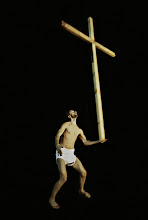Ringside
by Mem Morrison
In the faded grandeur of Shoreditch Town Hall, now available as a wedding venue, Mem Morrison’s Ringside traces through fragments of past weddings in a kind of ghost-dance with heritage and tradition. Eighty audience members sit around a large U-shaped table, each listening to music and monologues through individual headsets, while Morrison and 18 volunteers, all women, perform as host and hostesses in the middle of the space.
Welcomed like a guest as much as like an audience member, I experience myself drifting through a strange blend of the real and the symbolic in which each becomes caught up in the other. There’s a spectacular parade of plates, glasses, and place-settings – but they’re just simple drawings printed on cardboard boxes. The women make sham dresses and veils out of thin plastic bags – but then they coax some of us onto the floor for a dance that is awkward as only reality can be. Archival wedding films, genuine but of another time, are juxtaposed with a live feed of the present assembly, who are not real guests but who are really here. New stories are superimposed over old photographs, and the mediation of the entire event through headphones makes the whole thing slightly out of sync with itself.
This blend suits Morrison’s subject: the nature of the wedding celebration is itself such a confusion of the real and the symbolic. The dominance of the colour white, the order of events, the carefully chosen costumes, the public display of it all, and of course the weighty consequences of a few spoken words … these symbolic elements all gesture toward a reality which is so significant that it needs elaborate codes to contain it. But these codifications also naturalise social roles and expectations, producing them as natural and unavailable for interrogation. Ringside examines some of the more obvious and suspect of these codes – the bizarre persistence of rituals based on the rupture of the virgin bride’s hymen – but also some of the less obvious ones, such as the distinctions between childhood and adulthood and the compulsive demand for generational continuity.
Another social form which blends the real and the symbolic is the cliché: those supposedly fictional generalisations which in reality end up becoming self-fulfilling. When performance engages with cliché there is often the danger of reproducing it such that the performance itself becomes clichéd, and Ringside walks this line. I felt uncomfortable with the way the form of the piece often rested uncritically upon tropes of performance participation, or the evocation, with which the piece ends, of the too familiar image of the marriage-phobic male. But there are moments, achieved through the delicate care of Morrison’s writing, or in the way his movement and dancing put his own body on the line, in which form and content become much more fluid, and the real and the symbolic become intermingled, undistinguishable, and unconstrained by tradition. This spillage, perhaps, is what performance can do.
Theron is a writer and performer. http://www.newworknetwork.org.uk/theron

.jpg)
No comments:
Post a Comment